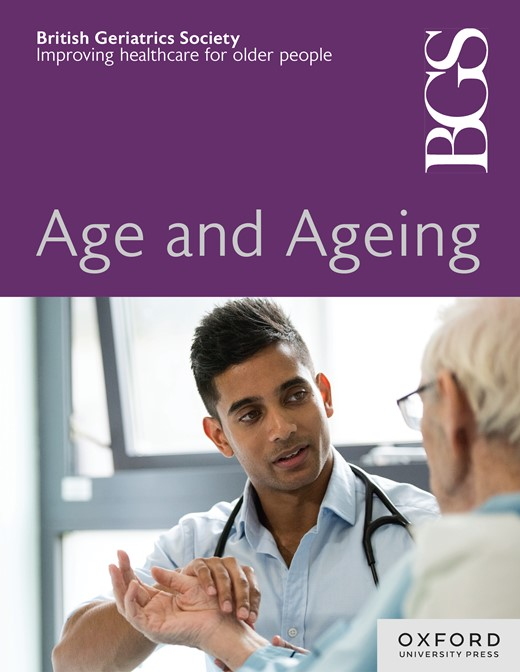Head-up tilt testing in older syncope patients: a systematic review
IF 6
2区 医学
Q1 GERIATRICS & GERONTOLOGY
引用次数: 0
Abstract
Background In older syncope patients, medical histories are often less reliable due to retrograde amnesia and cognitive impairment. Therefore, additional tests may be needed to reach a diagnosis. We conducted a systematic review to evaluate positivity rates and safety of head-up tilt testing (HUTT) in these patients. Methods We searched Medline and Embase for HUTT positivity rates and diagnoses in older syncope patients (mean age ≥ 65 years) vs. younger patients. Secondary outcomes were time to syncope (TtS) and adverse events (AEs). Risk of bias was assessed with a modified version of the QUADAS-2. Results In total, 42 studies were included, with 12 378 older participants in total. Positivity rates varied widely [passive HUTT 0.0%–90.0%; isoproterenol (IPR)-HUTT 18.3%–64.0%; nitroglycerin-HUTT 30.1%–90.5%]. The majority of studies found no differences between older and younger patients. Specificity was high for all HUTT-protocols (85.5%–100%). TtS did not differ between older and younger patients, but was significantly longer in control subjects. Nitroglycerin-HUTT yielded the most diagnoses (median 64.2% vs. 23.7% for passive, P = .007, and 44.8% for IPR-HUTT, n.s.). Vasodepressive responses were more common than cardioinhibitory responses (median 54.9% vs. 9.1%) in older patients. AEs occurred in <6% of patients with passive/nitroglycerin-HUTT. Discussion/conclusion There is no consistent evidence that HUTT results differ between older and younger syncope patients. Nitroglycerin-HUTT yields the most diagnoses, whilst retaining a high specificity, and is safe to perform in older patients. Future studies should focus on the additional value of HUTT on top of the initial evaluation in these patients.老年晕厥患者的平视倾斜试验:一项系统综述
背景在老年晕厥患者中,由于逆行性遗忘和认知障碍,病史往往不太可靠。因此,可能需要进行额外的检查才能做出诊断。我们对这些患者进行了系统回顾,以评估平视倾斜试验(HUTT)的阳性率和安全性。方法通过Medline和Embase检索老年晕厥患者(平均年龄≥65岁)和年轻患者的HUTT阳性率和诊断率。次要结局为晕厥时间(TtS)和不良事件(ae)。偏倚风险采用改良版QUADAS-2进行评估。结果共纳入42项研究,共有12378名老年参与者。阳性率差异很大[被动赫特0.0%-90.0%;异丙肾上腺素(IPR)-HUTT 18.3%-64.0%;nitroglycerin-HUTT 30.1% - -90.5%)。大多数研究发现老年和年轻患者之间没有差异。所有hutt方案的特异性都很高(85.5%-100%)。TtS在老年和年轻患者之间没有差异,但在对照组中明显更长。硝酸甘油- hutt的诊出率最高(中位数为64.2%,被动为23.7%,P = 0.007,知识产权- hutt为44.8%,n.s)。在老年患者中,血管抑制反应比心脏抑制反应更常见(中位数为54.9%对9.1%)。6%的被动/硝酸甘油- hutt患者发生ae。讨论/结论没有一致的证据表明老年和年轻晕厥患者的HUTT结果不同。硝酸甘油- hutt的诊断率最高,同时保持了高特异性,并且对老年患者是安全的。未来的研究应侧重于在这些患者的初步评估之上的HUTT的附加价值。
本文章由计算机程序翻译,如有差异,请以英文原文为准。
求助全文
约1分钟内获得全文
求助全文
来源期刊

Age and ageing
医学-老年医学
CiteScore
9.20
自引率
6.00%
发文量
796
审稿时长
4-8 weeks
期刊介绍:
Age and Ageing is an international journal publishing refereed original articles and commissioned reviews on geriatric medicine and gerontology. Its range includes research on ageing and clinical, epidemiological, and psychological aspects of later life.
 求助内容:
求助内容: 应助结果提醒方式:
应助结果提醒方式:


